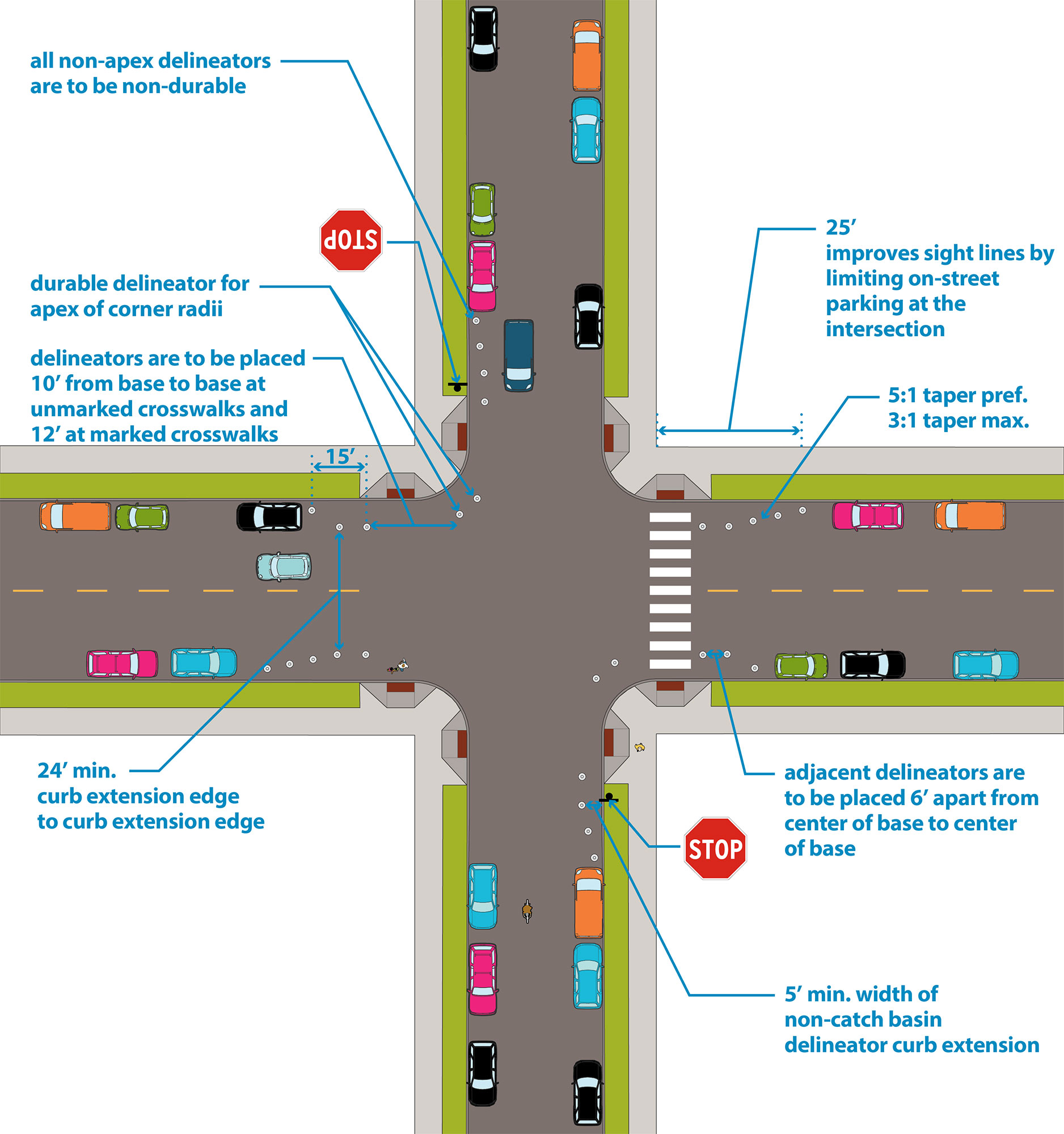Delineator curb extensions are intended to increase safety, calm motorized traffic, decrease the crossing distance for pedestrians and bicycles, and create additional space for pedestrians and bicycles.
Introduction
Delineator curb extensions, also known as bump outs, utilize plastic delineators or “bollards” and are an extension of the sidewalk zone or curb line into the roadway zone at intersections. Delineator curb extensions are intended to increase safety, calm motorized traffic, decrease the crossing distance for pedestrians and bicycles, and create additional space for pedestrians and bicycles.
Delineator curb extensions provide the following benefits:
- Improved sightlines between drivers, pedestrians, and bicycles.
- Reduced pedestrian and bicycle crossing distance, thereby reducing pedestrian and bicycle exposure to potential vehicle conflicts.
- Can slow vehicle turning speeds by decreasing turning radii and visually narrowing the roadway.
- Restrict cars from parking too close to the intersection and inhibiting sightlines.
Figure 3.7H.3:
Delineator curb extensions

Design Considerations
|
Location
|
- Delineator curb extensions are generally used at intersections where full-time parking lanes are present or excess travel lane width is present.
-
Exceptions include intersecting Urban Neighborhood streets where a traffic circle is preferred and Production and Processing where they should be considered but may not be appropriate given the frequency of large trucks.
-
Delineator curb extensions can extend into one or multiple legs of an intersection depending on the configuration of parking lanes.
-
Delineator curb extensions can also be used midblock to support additional traffic calming or for midblock pedestrian and bicycle crossings.
- See parking and intersection visibility guidance for additional information.
|
|
Delineator placement and spacing
|
- Delineators are not to be placed within the gutter of the roadway.
- Delineators are to be offset by at least 1’ from all striping, including the stop bar and crosswalk.
- When a delineator curb extension extends into multiple legs of an intersection depends on the intersecting street type and traffic safety needs.
-
Typically, a delineator curb extension does not extend into the leg of an Urban Neighborhood street on the far side of the intersection.
-
A delineator curb extension can extend into multiple legs of the intersection with an Urban Neighborhood street when the curb extension is on the approach side of the street.
- Adjacent delineators are to be spaced 6’ apart from center of base to center of base.
- Delineators are to be spaced 10’ apart from base to base at unmarked crosswalks, and 12’ apart at marked crosswalks.
- Where catch basins are present, a minimum of 6’ of clearance from a delineator is required through the catch basin to accommodate maintenance needs.
- Turning vehicles
-
Delineator curb extensions may restrict turning movements to and from intersecting streets. Designers should consider appropriate design and control vehicles and model all necessary turning movements.
-
Turning movements for bus routes, including dead head routes, should be modeled to determine delineator curb extension feasibility and placement.
|
|
Bollard type
|
A durable white style delineator is to be used for the apex, typically 2 delineators, of the radii to accommodate maintenance operations and due to their location and exposure. Standard white style delineators are used for the non-apex portion.
|
|
Width
|
- Delineator curb extensions should typically extend far enough into the roadway to narrow the travel lanes to recommended widths (see lane widths).
-
When more than 10' is available for traffic safety improvements, multiple safety treatments should be considered, such as pairing a curb extension with a delineator median or pedestrian and bicycle safety island.
- Delineator curb extensions are to be offset by at least 1’ from a travel lane, bikeway, or parking lane.
- The minimum width of a delineator curb extension is 5’ to maintain its effectiveness as a traffic calming tool.
- The minimum opening or “throat” for a 2-way street is 24’.
- The minimum opening or “throat” for a 1-way street is 20’.
|
|
Length
|
- The vehicle approach end of a delineator curb extension is typically 25’.
- A delineator curb extension that extends into multiple legs of an intersection, is to have a typical far side length of 15’.
|
|
Taper
|
- A taper of 5:1 (5’ of length for every 1’ of width adjustment) is preferred for delineator curb extensions.
- A taper of 3:1 can be used in locations where there is a demonstrated high on-street parking demand, parking meters are present, and/or there is proximity to a driveway or bus stop.
|
|
Bikeway considerations
|
- A taper of 5:1 (5’ of length for every 1’ of width adjustment) is preferred for delineator curb extensions.
- A taper of 3:1 can be used in locations where there is a demonstrated high on-street parking demand, parking meters are present, and/or there is proximity to a driveway or bus stop.
|
|
Installation considerations
|
Delineators are to be bolted to the pavement per manufacturer specifications. If used on a bridge deck, the delineators are to be adhered with butyl pads.
|
|
Maintenance considerations
|
When delineators are routinely missing or damaged, changes to placement and overall placement are to be considered to maintain the effectiveness as a traffic calming tool.
|



